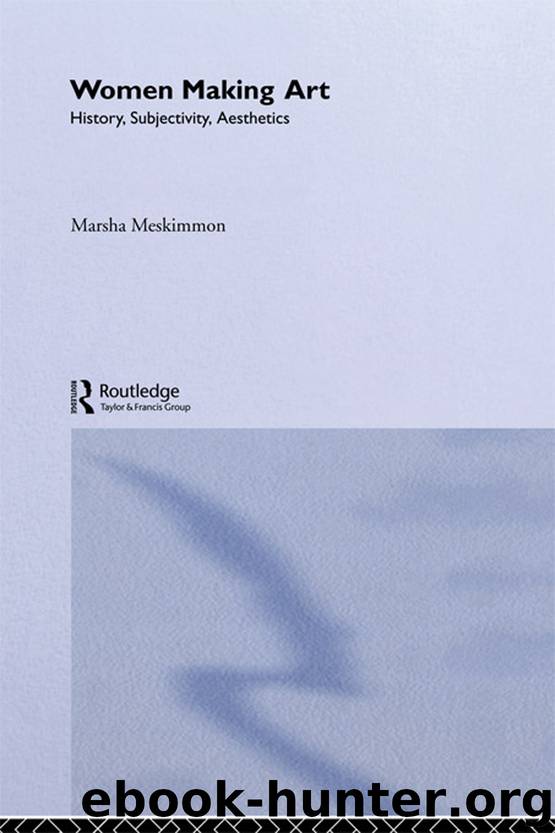Women Making Art by Meskimmon Marsha

Author:Meskimmon, Marsha.
Language: eng
Format: epub
Publisher: Taylor & Francis (CAM)
Figuring the body in the virtual machine
The ‘new’ technologies of genetic in(ter)vention, cyber-space and ‘virtual reality’ are among the most recent group of scientific developments to have had a massive impact on social life and ideas. Digital technologies especially have moved swiftly to encompass a mass, western audience and have become part of the daily routine of communication, information gathering and distribution, providing entertainment and sources of knowledge about the world and our relation to it. However, as I write these lines in the midst of US and British bombing raids on Afghanistan, it is telling that a report in The Sunday Times listing the percentages of the population with Internet access in seventeen North African and Middle Eastern countries ranges from ‘negligible’ in Iraq, Bahrain and Qatar to a minimal 6.3 per cent in Lebanon.24 The digital realm is neither beyond the power politics of the old ‘analog’ nation-states, nor the structures of class, wealth and access in the global economy.
Nor can digital technology be divorced from the historical legacy of iniquitous gender and race relations and to celebrate the appearance of a virtual subject, beyond the limits of class, race and sexual difference, is premature. As Keith Ansell Pearson warns:
. . . this vision of neg-entropic destinies, in which the human plays the role of a mere conduit in the inhuman process of complexification, can only provide simple options that are not options at all, such as a retreat into a new ethical purism . . ., futile Ludditism, or vacuous cyber-celebrationism.25
Yet it is clear that advances in media and communication technologies can provide extraordinarily powerful tools with which to re-envisage relations in the world in new and positive ways. Doing so means producing figurations which engage the technology as both embodied and embedded in histories and the languages of difference.
Australian artist Anna Munster has been exploring the problematic of ‘digital embodiment’ through just such a multi-stranded figuration in her Wundernet (http://wundernet.cofa.unsw.edu.au/), uploaded in 2000. The site is transitional in many senses. It is, for example, a preliminary experiment within a larger project to produce a multi-media CD-ROM designed to incorporate an even more sophisticated form of interactivity and image base. The structure of Wundernet is also transitional, taking viewers through changes of scale, form, media and, most suggestively, site, as it hyperlinks participants to other locations as part of its operating logic. But I would like to press the concept of transition even further and suggest that Wundernet is premised upon a form of transitional agency, linked to Munster's broader, feminist approach to digital practice and echoing Braidotti's comment that the ‘feminist theoretician today can only be “in transit”, moving on, passing through, creating connections where things were previously disconnected or seemed unrelated, where there seemed to be “nothing to see” ’.26
Wundernet creates diverse connections in transit, making visible correspondences between texts, moving images and a range of extra-site links. The connections across these varied elements are machinic (multiple, heterogeneous and temporary), rather than linear or teleological, yet they are not random, circulating in and around the politics of the body, virtuality and display.
Download
This site does not store any files on its server. We only index and link to content provided by other sites. Please contact the content providers to delete copyright contents if any and email us, we'll remove relevant links or contents immediately.
The Art of Boudoir Photography: How to Create Stunning Photographs of Women by Christa Meola(18583)
Red Sparrow by Jason Matthews(5428)
Harry Potter 02 & The Chamber Of Secrets (Illustrated) by J.K. Rowling(3646)
In a Sunburned Country by Bill Bryson(3509)
Drawing Cutting Edge Anatomy by Christopher Hart(3488)
Figure Drawing for Artists by Steve Huston(3412)
Harry Potter and the Prisoner of Azkaban (Book 3) by J. K. Rowling(3325)
The Daily Stoic by Holiday Ryan & Hanselman Stephen(3266)
Japanese Design by Patricia J. Graham(3139)
The Roots of Romanticism (Second Edition) by Berlin Isaiah Hardy Henry Gray John(2888)
Make Comics Like the Pros by Greg Pak(2883)
Stacked Decks by The Rotenberg Collection(2846)
Draw-A-Saurus by James Silvani(2689)
Harry Potter and the Deathly Hallows (7) by J.K. Rowling(2682)
Tattoo Art by Doralba Picerno(2627)
On Photography by Susan Sontag(2608)
Churchill by Paul Johnson(2544)
The Daily Stoic by Ryan Holiday & Stephen Hanselman(2528)
Drawing and Painting Birds by Tim Wootton(2475)
